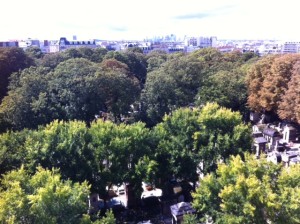In 1975, during a roundtrip tour of the U.S. — from sea to shining sea (to shining sea) — my brother and I pulled into Gettysburg late one evening. We found a motel that seemed tidy and inexpensive enough, and were soon asleep in our ground-floor room.
When we woke the next morning, one of us pulled aside the curtain hanging over a sliding back door … and saw that the National Cemetery at Gettysburg began about five yards away. Which sorta creeped us out.
Nearly 40 years later, four of us have moved into a room on the sixth floor of a building in the 18th arrondissement of Paris, and directly across the street from us, commanding the view from the four windows that face west, is the Montmarte Cemetery.
Which still kinda creeps me out.
A fair number of Americans from the Baby Boomer generation, and subsequent generations, know death mostly as a concept. Not a reality. We probably have not been with someone when they died. We have trouble contemplating our own deaths (and rarely try).
Cemeteries play such a prominent role in horror movies, with Poltergeist (where spirits of the dead are antagonistic) being perhaps the best known in the past three decades. Exactly the sort of pop culture that has made cremation such a popular choice in recent years; no cemeteries (which are sure to fall into ruin and be plowed over, eventually) for us.
Short term, anyway, it is hard not to think of death when we look out the window and see acres and acres of funeral monuments, some of them nearly two centuries old, across the narrow Rue Joseph-de-Maistre.
Crypts shaped as small homes or perhaps churches are common. This is not a Forest Lawn franchise, where head stones are banned (and sunk into the turf, instead) for the sake of ease in mowing the lawn. Every burial place seems made of stone, and is raised above ground. Lots of trees. No grass.
Thus, the Montmarte Cemetery looks like the cemeteries of our nightmares and our pop media.
Some famous people are down there. Not Pere Lachaise famous, but Montmarte is not doing badly, particularly when it comes to the arts, given the district’s history with same.
The wiki link lists many of them. I recognized at least three composers (Berlioz, Offenbach, Delibes), two writers (Heinrich Heine, Dumas fils), a painter (Degas), two physicists (Foucault and Ampere), a dancer (Nijinsky), a motorcycle rider (Patrick Pones, killed at the British GP in 1980) and a couple of singers (Dalida and Carole Fredericks).
The last two are of particular interest.
Dalida was a hugely popular singer and actress in Europe and North Africa (not so much in the New World), a woman of Italian heritage who was born in Cairo and sang in several languages and had a particularly chaotic personal life, with lots of suicides (including her own).
Carole Fredericks was born in the U.S. but became a popular singer in Paris. And she also is notable for being the most recent interment (2001) in Montmarte. A large majority of residents have been there since the 1800s.
To look at it … the cemetery looks pretty much maxed out, with crypts and monuments almost abutting.
Perhaps the only people accepted, these days, are those who have a family crypt already there, or are particularly popular and for whom space is made.
And it still creeps me out.
Maybe if we were to look at it a lot longer than a week, I would become used to it, and come to some intellectual accommodation with it. And perhaps gain a little more insight into the concept of being dead and buried.


0 responses so far ↓
There are no comments yet...Kick things off by filling out the form below.
Leave a Comment